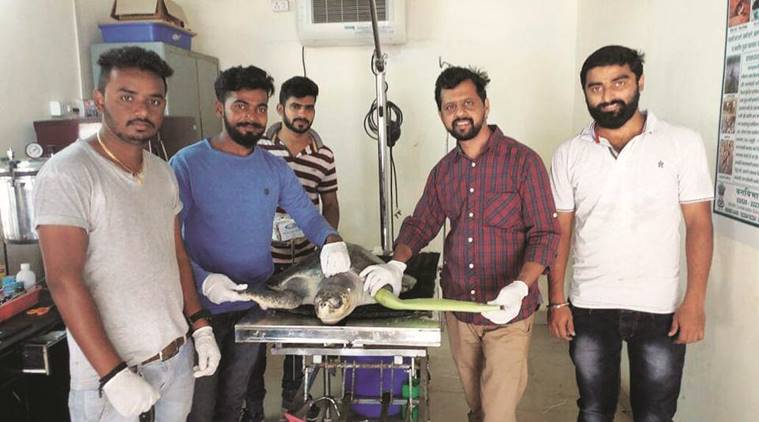
In Dahanu, a group of college students, veterinarians and animal activists take distressed and injured turtles to the Injured Sea Turtle Treatment and Transition Centre. While battling the injuries and diseases, the doctors there also focus on signs of ‘stress’ or ‘depression’ in the sea turtles, which they exhibit due to injury or too much human interference.
“Many times, the turtle can swim with two or three flippers. But the loss of one of the frontal flippers renders them incapable. In one such case, we had attached a ‘Dahanu flipper’ made out of plastic,” said Dr Dinesh Vinherkar, the primary veterinarian at the centre. Namo, was one of the several Olive Ridley Turtles that were rescued and taken to the centre in 2017. He had the ‘Dahanu Flipper’ attached and was left in the wild, with no tracking.
“The turtles that come to us are mostly from four major types that live in the coastline around Mumbai, Raigad and Palghar. These are the green sea turtles, loggerhead turtles, Olive Ridley turtles and the Hawk billed turtles,” said Dr Vihnerkar. “Turtles are Schedule I animals, and their hatching is celebrated across the world. But most adult turtles don’t even get to the age of mating, because of several factors, the majority of which are caused by humans,” he said.
The turtles that come to the centre in Dahanu suffer from a myriad of issues, but many show signs of ‘depression’. “Turtles suffer from stress whenever something is wrong with them. Be it a flipper injury, or buoyancy related issues or some internal disease like renal failure. The minute they can’t swim in the sea the way they want to, they start experiencing stress,” Dr Vinherkar said. Even being around humans causes stress in turtles and they manifest it in many ways, the primary being the disinclination to eat. “They stop eating so we have to hand-feed them. In some cases we put in a stomach feeding tube and provide them with nutrients,” he said.
The transit centre is run by the Wildlife Conservation and Animal Welfare Association along with the help of the Dahanu forest division, started as a single ditch dug 3×3 feet and laid with tarpoline, for one turtle in 2012. “As the years passed, the number of turtles coming to us have increased. This is partly because there is more awareness amongst the fishing community,” Dr Vihnerkar said. But the reality is that boat propellers, oil spill, thin fishing nets and even growing pollution are affecting the turtles more and more. “Sometimes, there are diseases that affect turtles naturally. But sometimes, we have seen, that the disease was caused because of some sort of pollutant that the turtle ingested and it reacted violently within their systems. There have been cases of renal failures and gastric issues, which were not caused normally,” Dr Vihnerkar added.
He said each species sustains itself on a different diet. “Their feeding habits differ, as some sustain on sea grass, whereas some are omnivorous. We collect sea grass and other nutritious items from the sea beach during low tide, and support it with external nutrients whenever possible,” Dr Vihnerkar said.
The turtles from the centre are generally released as soon as they show the signs of normalcy. “Even without one or two flippers, the turtles can swim and mate. We send them back into the sea, so that they can live their lives in natural environment as best as they can,” said Dr Vihnerkar.